ライトニングトークの記録 English
TOP > 映画の復元と保存に関するワークショップライトニングトークの記録 English
On the first day of “The 9th Film Restoration and Preservation Workshop” in August 2014, the program included talk sessions of five to 10 minutes each by a total of 17 speakers, covering 15 topics. Celebrating UNESCO’s “World Day for Audiovisual Heritage 2014″, we translated five of them into English, hoping that their passion could be shared worldwide. We would like to thank the speakers who gave us their kind permission to use those selected below.
1. Ensuring Film Projection Environment, “F Cinema Project”
Mami Kanda and Aki Nishikawa from Community Cinema Center
 Hello, everyone. I’m Mami Kanda, a researcher of Community Cinema Center’s F Cinema Project; I’m Aki Nishikawa, another researcher. Community Cinema Center is an umbrella organization for film exhibiters working at art house cinemas and screening venues in Japan. For more details of our various activities, such as special screenings all over Japan and the screening project for the area devastated on 3.11 called “Cinema Yell Tohoku”, please take a look at our website. This workshop itself is about film restoration and preservation, however our research is heavily focusing on screenings, and we hope you do not mind this.
Hello, everyone. I’m Mami Kanda, a researcher of Community Cinema Center’s F Cinema Project; I’m Aki Nishikawa, another researcher. Community Cinema Center is an umbrella organization for film exhibiters working at art house cinemas and screening venues in Japan. For more details of our various activities, such as special screenings all over Japan and the screening project for the area devastated on 3.11 called “Cinema Yell Tohoku”, please take a look at our website. This workshop itself is about film restoration and preservation, however our research is heavily focusing on screenings, and we hope you do not mind this.
Well, our main topic today, F Cinema Project, is a project to keep film projection possible. F Cinema Project has already been holding screenings, symposiums, and so on, but in the course of this we have now started a brand new line of research. Recently, especially after Fujifilm discontinued manufacturing all motion picture film products other than those for archival use, the environment around motion picture films has been drastically changed, and we assume that many of you have a sense of crisis about film’s future. Nonetheless, even within the film industry, the sense of crisis would be different depending on which area you belong to, such as distribution companies, street cinemas, film archives, or film labs. Therefore, we started research aiming to assemble and share the problems of each area and build up a network of people who are active in the field to make good use of the information to maintain an environment where we can enjoy the film projection experience for as long as possible.
First of all, to know what we actually need for maintaining film projection, we are undertaking research consisting of three parts. The first is about how to obtain film prints. Especially, we have to hurry to save those films at risk, which are stored at film labs for the time being but film distribution companies actually cannot afford the storage fees. We must find out what exactly is happening and look for a solution. As a long-term objective, we also would like to know about the continuation of film manufacturing and lab techniques.
The second part is about the present situation of film projectors and technicians. All film projectionists are, in a way, technicians, but we think highly of film projectionists who are able to maintain and repair film projectors. Also, we cannot forget about companies doing on-demand film projection, as they are so important for future film screenings. We are going to list up and update the information on the Community Cinema Center’s website before April 2015.
The third part is about venues. There are a lot of theaters and public halls in Japan that are equipped with film projectors, but they are used less and less. We are sending questionnaires to venues, and if they would like to continue film projection but cannot for some reason, then we would like to know why. If the reason is a lack of maintenance or technicians, we can make film projection possible for them with our information resources. That was about the point of the Community Cinema Center’s F Cinema Project.
Please allow me to talk about my personal project, too. I (Mami Kanda) started film projectionists’ oral history a few years ago. Last year (2013) after this very workshop I dropped off at an adult movie theater called “Cinerama Power” in Aichi pref. and got to know that the owner had a problem with an old projector lens. Afterwards I asked my supplier friend to find a lens in better condition to send to her. She was happy and said that the quality of the picture had much improved. My purpose is interviewing and making a record of film projectionists but this is an example of solving a problem by networking. I would like venues all over Japan to exchange information and projector parts smoothly through the F Cinema Project’s network from now on.
>> Planetary Projection: Mami Kanda
This project has just begun and we are still finding our way. Please let us know any information you could give us about film, projector parts, maintenance etc. And we will probably ask many of you in the audience a favour so please be kind and cooperate with us. This October (2014), Community Cinema Center is holding an annual conference, and F Cinema Project will have a study meeting. We hope we’ll see you there again. That’s all for now. Thank you.
2. Prospect for Home Movie Research in Film Study
Yutaka Kubo from Kyoto University
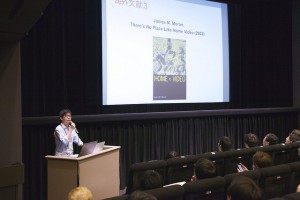 Hello. My name is Yutaka Kubo. I’m a PhD candidate from Kyoto University specializing in film director Keisuke Kinoshita, and also in Home Movies. As I submitted my MA thesis with help from Kobe Planet Film Archive, Film Preservation Society, and people who joined Home Movie Day, today I will briefly talk about the present state and the objectives of home movie study in Japan based on my thesis.
Hello. My name is Yutaka Kubo. I’m a PhD candidate from Kyoto University specializing in film director Keisuke Kinoshita, and also in Home Movies. As I submitted my MA thesis with help from Kobe Planet Film Archive, Film Preservation Society, and people who joined Home Movie Day, today I will briefly talk about the present state and the objectives of home movie study in Japan based on my thesis.
In my thesis, I started from the simple question, “Why do we make home movies” and thought about the meanings of home movies in film history, by discussing the relationship of a cameraman to the object. The reason is because home movies have been eliminated from the big framework in film study which begun in the 1960s in Japan. In fact, there is no such book specialising in home movies in Japanese film study as far as I know. Of course there are books and theses that partly discuss home movies as a sub-category of small gauge films or documentary films, however they tend to deal with film from the point of view of technique, history, cultural- or social-wise, and the discussion on what home movies really are, and their definition, were not enough.
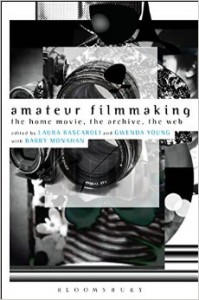 In the US and Europe, research books on home movies have been published constantly since 1986. There are early studies by Richard Chalfen or Patricia Zimmermann on snapshot pictures, shooting and screenings of amateur footage, and on top of these, there is James M. Moran’s book on home video, There’s No Place Like Home Video published in 2002. And as a big step in the research of home movies, Mining the Home Movie: Miming the Home Movie was edited by Karen I. Ishizuka and Patricia Zimmermann, aiming to discuss home movies from various points of view, or an academic perspective. Though not yet well known, at the beginning of 2014, Amateur Filmmaking: The Home Movie, the Archive, the Web was published, too. On the other hand, in Japan research on home movies is still underway. Today in this workshop, we already heard the words “networking” or “linkage” several times, and keeping these words in our mind, we are faced with several tasks.
In the US and Europe, research books on home movies have been published constantly since 1986. There are early studies by Richard Chalfen or Patricia Zimmermann on snapshot pictures, shooting and screenings of amateur footage, and on top of these, there is James M. Moran’s book on home video, There’s No Place Like Home Video published in 2002. And as a big step in the research of home movies, Mining the Home Movie: Miming the Home Movie was edited by Karen I. Ishizuka and Patricia Zimmermann, aiming to discuss home movies from various points of view, or an academic perspective. Though not yet well known, at the beginning of 2014, Amateur Filmmaking: The Home Movie, the Archive, the Web was published, too. On the other hand, in Japan research on home movies is still underway. Today in this workshop, we already heard the words “networking” or “linkage” several times, and keeping these words in our mind, we are faced with several tasks.
Firstly, the connection between audiovisual media and researchers is weak. In the US or Europe, the reason for such rich results of home movie research is the easy access to both national and private, and both physical and digital film archives. Our task here is to build up much stronger and more flexible relationships with collecting organizations. For this point, “Natsukashisa-ha mirai to tomoni yattekuru” (Gakubunsha, 2013) by Ken’ichi Harada (Niigata University) is one of the good references. Secondly, though I’m telling it also to myself, communication between researchers who are into home movies is not so great. Of course even now, there’s a network of HMD organisers, but by enhancing people’s relationships among much wider fields, activities such as HMD could be even more successful.
To advance the study of home movies, we should re-define home movies. In my MA thesis I defined home movies as “The home movie is a non-commercial family film that not only represents an intimate relationship between filmmaker and subject but also depicts a cycle of human life”. At the same time, I know it really differs from person to person. And even the research results overseas haven’t given us a clear-cut definition yet. In other words, home movies are in such a diverse and complicated category.
I’m going to continue this study so please feel free to let me know your opinion. That is all for my presentation.
3. Introducing Film Storage Service
Hirokazu Tazawa from Kyoshin Warehouse Co., Ltd.
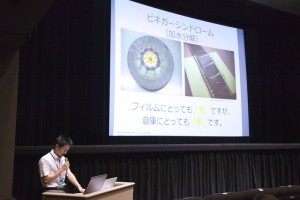 I’m Hirokazu Tazawa, from Kyoshin Warehouse Co., Ltd. We are located in Tobitakyu, Chofu-city where Kadokawa and Nikkatsu have got film studios. Since there are many movie related companies, Chofu is revitalizing the area as “City of Movies”. For example, Chofu Sightseeing Association is annually holding “Kinder Film Festival”, a film festival for kids. As a company in Chofu, “City of Movies”, we started a film storage service about 25 years ago, and all the films are stored on shelves in a climate-controlled warehouse. Now we have quite a range of motion picture films from those in brand new cans to old rusty cans.
I’m Hirokazu Tazawa, from Kyoshin Warehouse Co., Ltd. We are located in Tobitakyu, Chofu-city where Kadokawa and Nikkatsu have got film studios. Since there are many movie related companies, Chofu is revitalizing the area as “City of Movies”. For example, Chofu Sightseeing Association is annually holding “Kinder Film Festival”, a film festival for kids. As a company in Chofu, “City of Movies”, we started a film storage service about 25 years ago, and all the films are stored on shelves in a climate-controlled warehouse. Now we have quite a range of motion picture films from those in brand new cans to old rusty cans.
The more films we store, however, the more problems occur, and the main one is, as you all know, “Vinegar Syndrome”. Vinegar Syndrome is evil for films but it is also evil for the warehouse itself. The reason is because Vinegar Syndrome destroys the air conditioning. When we use air conditioning in the warehouse, the temperature of the gas pipe goes down, so in summer this pipe has condensation. The gas emitted by vinegar syndrome is going to melt into the condensation, and make the pipe rusty. When the rust advances, it becomes a hole in the pipe and the gas leaks. So we are replacing the indoor air conditioning equipment once a year.
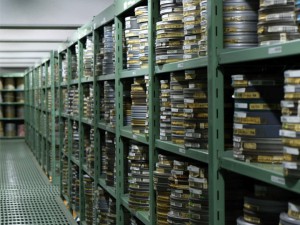 There are two main solutions for this acetic acid problem. Firstly, we set up low temperature (5°C), low humidity storage in 2009. Until then, we had stored films in a 20°C warehouse but in cold and dry conditions we can control the amount of vinegar acetic acid, and control the damage of both deterioration of films and damage to the air conditioning. Secondly, we set the filter to eliminate the acetic acid. Under the condition of 5°C, we can reduce the amount of acetic acid better than at 20°C, but we cannot stop it totally. Therefore, we use a filter to reduce the density of the acetic acid in the air. These are our answers, and so we store films in the cold and dry environment.
There are two main solutions for this acetic acid problem. Firstly, we set up low temperature (5°C), low humidity storage in 2009. Until then, we had stored films in a 20°C warehouse but in cold and dry conditions we can control the amount of vinegar acetic acid, and control the damage of both deterioration of films and damage to the air conditioning. Secondly, we set the filter to eliminate the acetic acid. Under the condition of 5°C, we can reduce the amount of acetic acid better than at 20°C, but we cannot stop it totally. Therefore, we use a filter to reduce the density of the acetic acid in the air. These are our answers, and so we store films in the cold and dry environment.
There are a lot other things to do to create better storage conditions for films. We hope we can help our customers in the film archival field by improving our environment so that films can be stored and passed on in as good a condition as possible for the long term. Please feel free to make contact with us for any inquiries and questions about storage of films. Thank you very much.
Kyoshin Warehouse Co., Ltd.
info(a)kyoshin-soko.co.jp
4. Research on Actress Yukiko Todoroki and Director Masahisa Sunohara
Hiroya Yamaguchi (Film Historian)
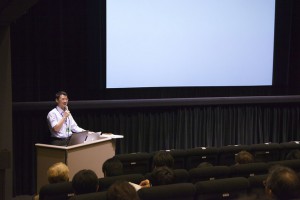 I’m Hiroya Yamaguchi from Osaka, a researcher of the actress Yukiko Todoroki. I attend this workshop every year so you may know me already. I do not belong to any institution, but individually do research on movies. I got to know Yukiko Todoroki through a book by Katsuhito Inomata published in 1977, and have been obsessed with her since then. Usually you fall in love with an actress by seeing movies or such – that would be normal – but I’m a little different and I was attracted to her through Inomata’s writing. As now I often write about movies, I really think I have to write well. “I got into Todoroki-san by your writing” or “I started seeing Sunohara’s films through your book” … it would be great if such a thing happened.
I’m Hiroya Yamaguchi from Osaka, a researcher of the actress Yukiko Todoroki. I attend this workshop every year so you may know me already. I do not belong to any institution, but individually do research on movies. I got to know Yukiko Todoroki through a book by Katsuhito Inomata published in 1977, and have been obsessed with her since then. Usually you fall in love with an actress by seeing movies or such – that would be normal – but I’m a little different and I was attracted to her through Inomata’s writing. As now I often write about movies, I really think I have to write well. “I got into Todoroki-san by your writing” or “I started seeing Sunohara’s films through your book” … it would be great if such a thing happened.
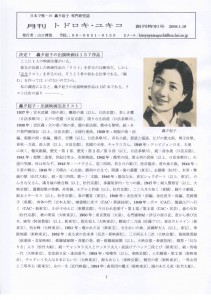 I’m asked things like, “You started it in High School and when are you finally publishing her book?”, but I’m not able to yet. Dealing with somebody’s life is not as easy you think, but, to cut out such excuses, I swore that I’d publish it in three years. 2017 is a memorial year as it is Todoroki’s centenary and 50 years after her death. I’m the kind of guy who makes efforts under pressure, so I really hope I can show it to you. There’s an article by myself published in Sankei Newspaper about Todoroki’s charm, so please take a look (“The importance of filmography, rediscovery of hidden people in the film industry” on 2014.07.01). And I have published by myself this free zine titled “Gekkan (Monthly) Todoroki Yukiko” since 2008. The latest issue is no 28. Please make contact with me if you are interested.
I’m asked things like, “You started it in High School and when are you finally publishing her book?”, but I’m not able to yet. Dealing with somebody’s life is not as easy you think, but, to cut out such excuses, I swore that I’d publish it in three years. 2017 is a memorial year as it is Todoroki’s centenary and 50 years after her death. I’m the kind of guy who makes efforts under pressure, so I really hope I can show it to you. There’s an article by myself published in Sankei Newspaper about Todoroki’s charm, so please take a look (“The importance of filmography, rediscovery of hidden people in the film industry” on 2014.07.01). And I have published by myself this free zine titled “Gekkan (Monthly) Todoroki Yukiko” since 2008. The latest issue is no 28. Please make contact with me if you are interested.
I got to know the family of film director Masahisa Sunohara when I was researching Yukiko Todoroki. At the beginning I just wanted to have a talk but as my research went on, I gradually realized that he was such a great director. That was just ten years ago, so it took me ten years to complete his filmography. This is going to be the first book on director Sunohara, but publishing a book is very expensive so please let me know if you would like to publish it for me. I don’t care if my name appears or not. This is purely for the reevaluation of director Sunohara, so I would happily donate it to the library in the film archives or such places. I hope you will read it.
I met a variety of people through my research into Todoroki. For example, Satoshi Hachinohe in Saitama Prefecture is a great person who described all the opening titles of all the films. Also, a researcher like Junko Iiwo, who does research on Buster Keaton and Jerry Lewis and is also attending this workshop. I would like to cooperate and exchange information with them, then advance my research. Thank you very much.
Contact: hiroyayamaguchi(a)bca.bai.ne.jp 090-7767-2254
5. Bring a Piano to the Cinema!
Mie Yanashita (Silent Film Pianist)
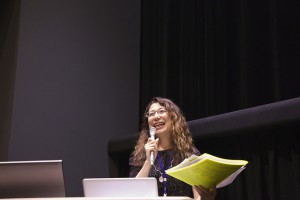 I’m Mie Yanashita, a silent film pianist. I usually talk to the screen with a piano, but today I’m facing towards you all, so I’m a little nervous. Forgive me if I don’t make sense. Today I’m talking about a project I’ve been working on since 2008 – “Bring a Piano to the Cinema!”.
I’m Mie Yanashita, a silent film pianist. I usually talk to the screen with a piano, but today I’m facing towards you all, so I’m a little nervous. Forgive me if I don’t make sense. Today I’m talking about a project I’ve been working on since 2008 – “Bring a Piano to the Cinema!”.
In the cinema there used to be a piano. In the movie history of about 120 years, in the first 40 years or so movies usually consisted of “film screenings” and “live music”. You may think that is in the past, but for example, film projection is shifting to digital projection, so people in the future might think film projection is in the past, right? This morning, Masanori Daibo said in his lecture about Film Restoration activities in the National Film Center, “film projectors are already “heritage””. In a same way, a piano used to be essential to the cinema, but is now forgotten and you never wonder why there is no piano in the cinema, I assume.
Actually, in Europe, cinema with a piano is not a rarity. For example, there are two especially well-known film festivals showing restored/archival films with live music; Il Cinema Ritrovato in Bologna and Le Giornate del Cinema Muto in Pordenone, a town located north of Venice. Il Cinema Ritrovato shows restored films for about ten days and the venues are four commercial theaters in the town. These four cinemas have got a piano. I’ve been to Museo Nazionale del Cinema in Torino and their cinematheque also has a grand piano. I’ve never been, but have heard La Cinémathèque Royale de Belgique has three venues and one of them specialises in silent films with live music.
I remember that for the first instance of this project “Bring a Piano to the Cinema!” was in a restored cinema in Hiroshima – Cinema Onomichi. I just found a piano and managed the shipping cost and tuning fees somehow and sent it to Onomichi to celebrate their grand opening. It’s not fully used yet but recently people understand my project and similar cases have often occurred. In the west part of Japan this year (2014), for example, Kobe Planet Film Archive installed a piano. Having a piano is a big step forward to an environment to show silent films properly. So I really appreciate it.
My ideal cinema is a cinema that can show any form of film without any struggles. Not to bring a piano for special events only, but there’s always a piano ready to use if they need it and can enjoy it all together. Only 120 years of film history – as Kiyotaka Moriwaki from Museum of Kyoto pinned it in 1,200 years of cultural history in Kyoto in his lecture this morning – live performance continued for 40 years, and film projection continued for 120 years. There are a variety of formats and styles of screenings and I hope all of it can be reproduced. That is my ideal.
I would like you to watch this here. You must know the comedy king Buster Keaton. In his Sherlock, Jr., a pianist is playing the piano facing the screen – you might have seen this film, but you might have missed the pianist.
I would like your kind support for “Bring a Piano to the Cinema!”.
Mie Yanashita’s information on Twitter @miesilentpiano, Tumblr, and Facebook
今後のイベント情報
- 12/03
- 動的映像アーキビスト協会(AMIA)会議
- 10/09
- 山形国際ドキュメンタリー映画祭 YIDFF 2025
- 09/08
- 保護中: FIAF倫理規定(改訂版 2025年4月)日本語訳
- 09/08
- 東南アジア太平洋地域視聴覚アーカイブ連合(SEAPAVAA)会議
- 08/16
- 紛争下の被災文化遺産と博物館の保護―スーダン共和国の事例から
映画保存の最新動向やコラムなど情報満載で
お届けする不定期発行メールマガジンです。
メールアドレス 登録はこちらから
関東圏を中心に無声映画上映カレンダーを時々更新しています。
こちらをご覧ください。
